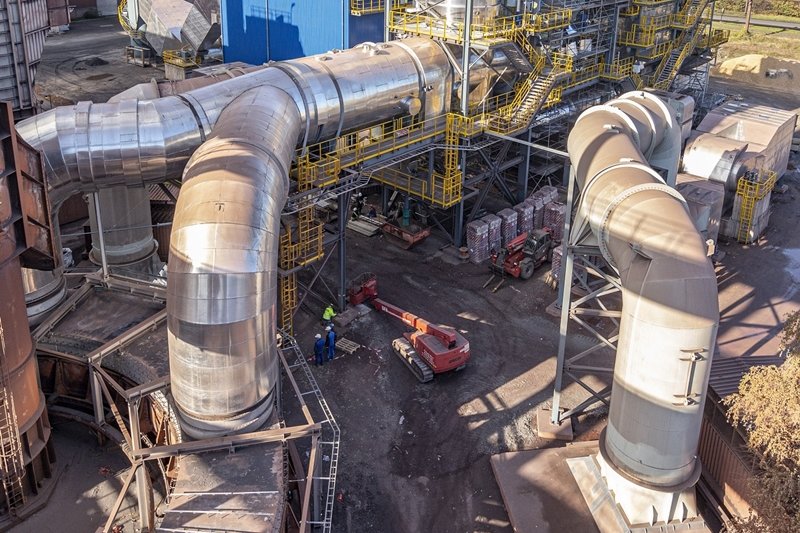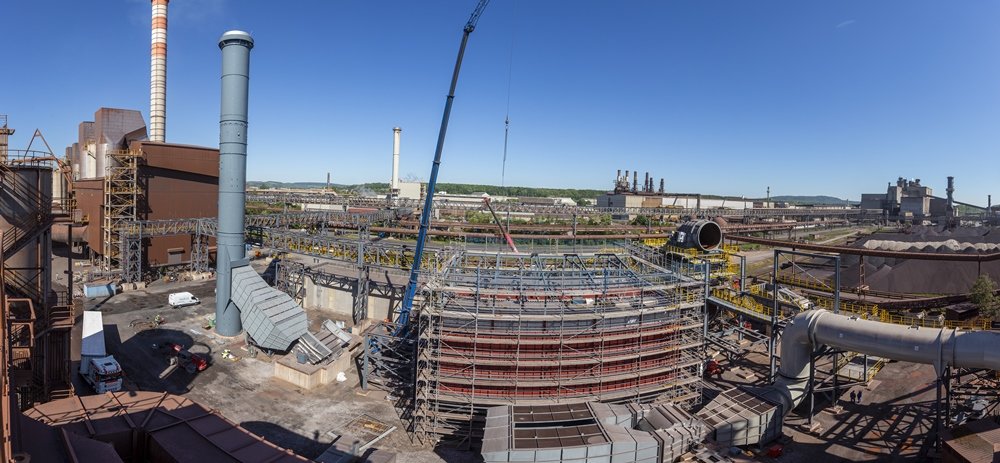
- News & Information
- Press Releases
More energy and lower emissions – new circular cooler dedusting system benefits the environment
17. March 2021
The new dedusting system for the circular cooler with an integrated heat recovery system at sinter plant 3 of ROGESA Roheisengesellschaft Saar mbH, a joint subsidiary of Dillinger and Saarstahl, is significantly helping improve environmental protection at the Dillingen location. The environmental project represents an investment of EUR 28 million.
The heat recovery generates an additional energy benefit of 82,000 MWh, which equals a reduction of carbon emissions of approx. 25,000 tons per year. The circular cooler dedusting itself significantly reduces dust emissions at the circular cooler. Although the use of hydrogen is currently the central topic of “green” steel production, much more time will be needed before sufficient hydrogen is available in industrially usable quantities. Until then, Dillinger and Saarstahl are optimizing their existing plants in terms of sustainability and climate protection on the way to producing carbon-neutral steel. The two companies have initiated environmental investments amounting to EUR 70 million during the last two years alone.
"With the new circular cooler dedusting system, we have successfully created a win-win situation for the environment and efficiency. The energy gained from heat extraction reduces carbon emissions and generates more electricity that does not need to be purchased. At the same time, dust emissions are being further reduced and recycled: we are thus continuing our efforts to ensure that the most sustainable steel companies are located at the Saar river,” said Martin Baues, Chief Technical Officer of Dillinger and Saarstahl, who gives the new circular cooler dedusting system high marks.
Additional heat extraction
A large-area cover on the circular cooler ensures that dust emissions generated as the sinter cools are extracted in a controlled manner and fed to a filtering system. The resulting exhaust air, with temperatures ranging from about 350 to 400 degrees Celsius, is also sucked in and fed to an additional integrated heat extraction system. The heat from the air is transferred there to a hot water circuit. This results in water heated to a temperature of about 190 degrees Celsius which is then used under high pressure to preheat the condensate circuit in the blast furnace gas power plant and to preheat the feed water in the companies at the site. The separated dust particles from the filter system are returned to the production cycle and recycled in the sinter plant. In the interests of efficient use of resources, care is taken to ensure that as much raw material and energy as possible are returned to the production cycle.
Technical facts and explanations:
What happens in a sinter plant?
Very fine-grained iron ores can clog a blast furnace. For this reason, a mixture of fine-grained iron ores, coke and other recycled materials is heated and burnt out in the sintering process. During this process, the iron ores form a solid, coarse-grained compound known as sinter cake. This is crushed again at the end of the process to a defined size. This finished sinter is smelted in the blast furnace. Particles smaller than the required size are reused and sintered again.
What is a circular cooler?
The circular cooler is a rotating belt on which the sinter cools to the required size prior to being further processed. At the start of cooling, the sinter has a temperature of about 1,000 degrees Celsius.
Click on the link to get an overview of the new installation:
(Dauer: )
Quelle:

Innovative top-quality steel products, total orientation around our customers' needs and unceasing technological development in close cooperation with our partners form the basis of our success - as they have for more than 333 years.
© 2016 Dillinger All rights reserved.
Contact
AG der Dillinger Hüttenwerke
Werkstraße 1
66763 Dillingen/Saar
Tel.: +49 6831 47 0
Fax: +49 6831 47 2212
E-Mail: info@dillinger.biz
Imprint
| Data privacy statement
| T&C




